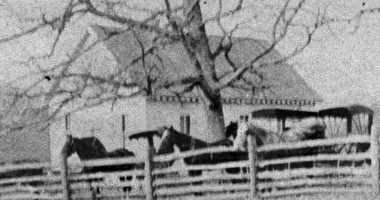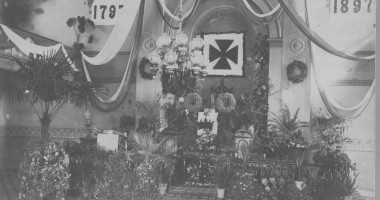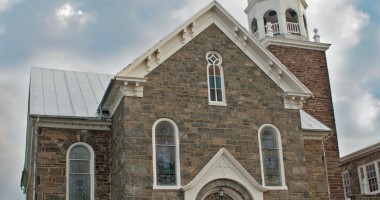By Frank Schmersal
The history of Elias Evangelical Lutheran Church begins with a small group of farmers, primarily of German heritage, in the Toms Creek Hundred area a few miles east of what is now Emmitsburg. In 1757 this group established a congregation that was visited about once a month by the Rev. John George Baugher, a German Lutheran pastor from Hanover, PA. Pastor Baugher founded more than one hundred congregations in Maryland and Pennsylvania.
A small, rough log church was built on what is now Four Points Bridge Road, with a cemetery across the road from it that is still in existence. In 1768 the Lutherans and the local German Reformed congregation joined forces to form a union church, and in 1782 they built a new frame church building which they shared, each led by its own visiting pastor.
In 1797 the Lutheran and German Reformed congregations moved into Emmitsburg and built a new stone church there, facing the road from Emmitsburg to Gettysburg (an old alignment of the present Irishtown Road.) The new church in Emmitsburg had a bell in a belfry, and an upstairs gallery where servants were seated. The sanctuary faced the west, with the altar against the west wall. The church at Toms Creek Hundred was sold to a Methodist congregation which is now Toms Creek Methodist Church; the building was torn down in 1905, after the present Toms Creek Church was built.
In 1814 a full steeple replaced the belfry. 92 feet high, the steeple was paid for through a state-authorized lottery. Entrance to the church was through the base of the steeple. Some of the timbers from the original belfry can still be seen in the attic of the church. The original weathervane from the steeple, an iron fish, was removed in 1859 because it was being used as a target by local marksmen; it is now mounted in a display case in the sanctuary. The steeple also held a clock with a wooden mechanism; some parts of the clock still exist in the church archives.
The Maryland Lutheran Synod was organized in 1820. The pastor who served Elias Congregation at the time, the Rev. John Grobp, was a leader in the organization and became the vice-president of the synod. Although there have been many mergers along the way, the present Evangelical Lutheran Church in America (ELCA) can trace its history directly back to the Maryland Synod.
Until 1828, the service was conducted in German. Both English and German services were conducted from 1828 until some years after the Civil War, when German services were ended.
The Union Academy was formed by the Lutheran and Reformed congregations in 1829 because of dissatisfaction with the public schools of the time. A building was erected adjacent to the church. Records of the Union Academy in the Elias archives show that there were never more than 40 students. The building was razed in 1870.
By 1835 more space was needed, and so the sanctuary was enlarged with an addition on the north side. The sanctuary, including the gallery, was turned to face the north, with the altar against the north wall. Despite the two-foot-thick stone walls, windows and doors were moved to maintain the symmetry of the structure. Entrance was still from the east. Read More







